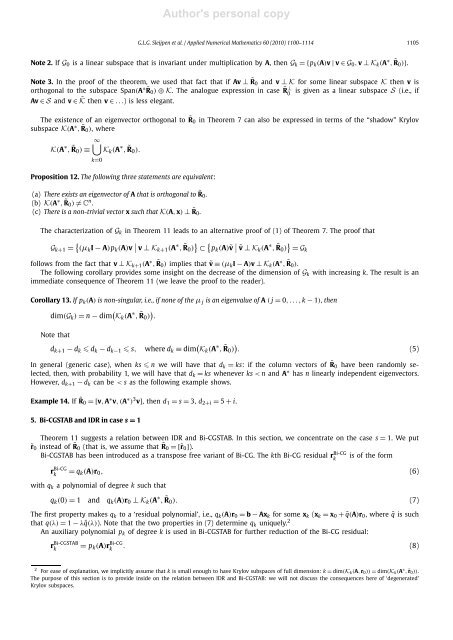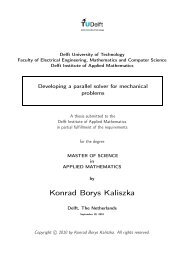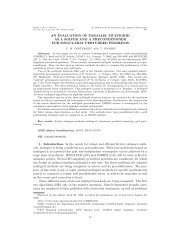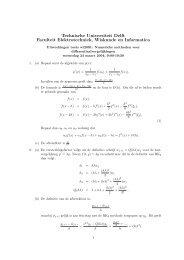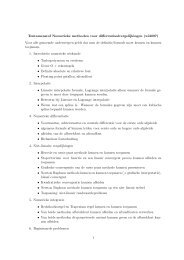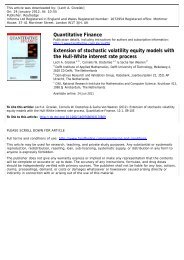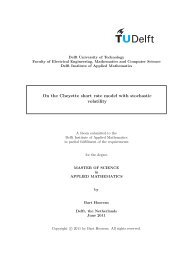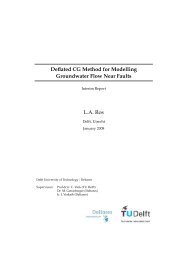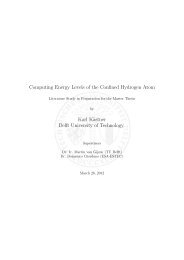Gerard L.G. Sleijpen, Peter Sonneveld and Martin B. van Gijzen, Bi ...
Gerard L.G. Sleijpen, Peter Sonneveld and Martin B. van Gijzen, Bi ...
Gerard L.G. Sleijpen, Peter Sonneveld and Martin B. van Gijzen, Bi ...
Create successful ePaper yourself
Turn your PDF publications into a flip-book with our unique Google optimized e-Paper software.
Author's personal copy<br />
G.L.G. <strong>Sleijpen</strong> et al. / Applied Numerical Mathematics 60 (2010) 1100–1114 1105<br />
Note 2. If G 0 is a linear subspace that is invariant under multiplication by A, thenG k ={p k (A)v | v ∈ G 0 , v ⊥ K k (A ∗ , ˜R0 )}.<br />
Note 3. In the proof of the theorem, we used that fact that if Av ⊥ ˜R0 <strong>and</strong> v ⊥ K for some linear subspace K then v is<br />
orthogonal to the subspace Span(A ∗ ˜R0 ) ⊕ K. The analogue expression in case ˜R⊥<br />
0<br />
is given as a linear subspace S (i.e., if<br />
Av ∈ S <strong>and</strong> v ∈ ˜K then v ∈ ...) is less elegant.<br />
The existence of an eigenvector orthogonal to ˜R0 in Theorem 7 can also be expressed in terms of the “shadow” Krylov<br />
subspace K(A ∗ , ˜R0 ), where<br />
K(A ∗ , ˜R0 ) ≡<br />
∞⋃<br />
K k (A ∗ , ˜R0 ).<br />
k=0<br />
Proposition 12. The following three statements are equivalent:<br />
(a) There exists an eigenvector of A that is orthogonal to ˜R0 .<br />
(b) K(A ∗ , ˜R0 ) ≠ C n .<br />
(c) There is a non-trivial vector x such that K(A, x) ⊥ ˜R0 .<br />
The characterization of G k in Theorem 11 leads to an alternative proof of (1) of Theorem 7. The proof that<br />
G k+1 = { (μ k I − A)p k (A)v ∣ ∣ v ⊥ Kk+1 (A ∗ , ˜R0 ) } ⊂ { p k (A)ṽ ∣ ∣ ṽ ⊥ Kk (A ∗ , ˜R0 ) } = G k<br />
follows from the fact that v ⊥ K k+1 (A ∗ , ˜R0 ) implies that ṽ ≡ (μ k I − A)v ⊥ K k (A ∗ , ˜R0 ).<br />
The following corollary provides some insight on the decrease of the dimension of G k with increasing k. The result is an<br />
immediate consequence of Theorem 11 (we leave the proof to the reader).<br />
Corollary 13. If p k (A) is non-singular, i.e., if none of the μ j is an eigenvalue of A ( j = 0,...,k − 1),then<br />
dim(G k ) = n − dim ( K k (A ∗ , ˜R0 ) ) .<br />
Note that<br />
d k+1 − d k d k − d k−1 s, where d k ≡ dim ( K k (A ∗ , ˜R0 ) ) . (5)<br />
In general (generic case), when ks n we will have that d k = ks: if the column vectors of ˜R0 have been r<strong>and</strong>omly selected,<br />
then, with probability 1, we will have that d k = ks whenever ks < n <strong>and</strong> A ∗ has n linearly independent eigenvectors.<br />
However, d k+1 − d k can be < s as the following example shows.<br />
Example 14. If ˜R0 =[v, A ∗ v,(A ∗ ) 3 v], thend 1 = s = 3, d 2+i = 5 + i.<br />
5. <strong>Bi</strong>-CGSTAB <strong>and</strong> IDR in case s = 1<br />
Theorem 11 suggests a relation between IDR <strong>and</strong> <strong>Bi</strong>-CGSTAB. In this section, we concentrate on the case s = 1. We put<br />
˜r 0 instead of ˜R0 (that is, we assume that ˜R0 =[˜r 0 ]).<br />
<strong>Bi</strong>-CGSTAB has been introduced as a transpose free variant of <strong>Bi</strong>-CG. The kth <strong>Bi</strong>-CG residual r <strong>Bi</strong>-CG is of the form<br />
k<br />
r <strong>Bi</strong>-CG<br />
k<br />
= q k (A)r 0 , (6)<br />
with q k a polynomial of degree k such that<br />
q k (0) = 1 <strong>and</strong> q k (A)r 0 ⊥ K k (A ∗ , ˜R0 ). (7)<br />
The first property makes q k to a ‘residual polynomial’, i.e., q k (A)r 0 = b − Ax k for some x k (x k = x 0 + ˜q(A)r 0 , where ˜q is such<br />
that q(λ) = 1 − λ˜q(λ)). Note that the two properties in (7) determine q k uniquely. 2<br />
An auxiliary polynomial p k of degree k is used in <strong>Bi</strong>-CGSTAB for further reduction of the <strong>Bi</strong>-CG residual:<br />
r <strong>Bi</strong>-CGSTAB<br />
k<br />
= p k (A)r <strong>Bi</strong>-CG<br />
k<br />
. (8)<br />
2 For ease of explanation, we implicitly assume that k is small enough to have Krylov subspaces of full dimension: k = dim(K k (A, r 0 )) = dim(K k (A ∗ , ˜r 0 )).<br />
The purpose of this section is to provide inside on the relation between IDR <strong>and</strong> <strong>Bi</strong>-CGSTAB: we will not discuss the consequences here of ‘degenerated’<br />
Krylov subspaces.


